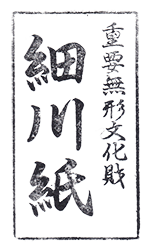ユネスコ登録の定義
The definition for UNESCO Listed Washi
ユネスコは平成26年11月27日(現地26日)、「人類が守るべき無形文化遺産の代表的な一覧」に、石州半紙、本美濃紙、細川紙を「和紙・日本の手漉和紙技術」として記載し、ユネスコ無形文化遺産に決定しました。個別の和紙名ではなく、手漉き和紙技術の登録です。
On November 27th, 2014, Sekishu-bamshi, Hon-Minoshi and Hosokawa-Shi were added by UNESCO to the Representative List of Intangible Cultural Heritage of Humanity. They are not listed by the names of individual Washi, but for the technique of handmade Washi.
